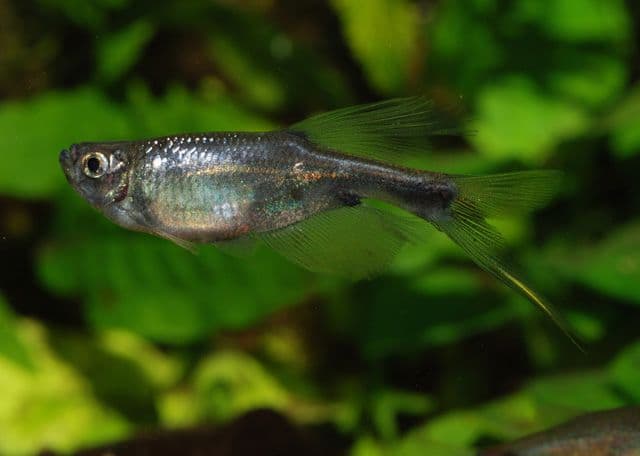
On a visit to one of our local pet shops last spring, I discovered a fish I could not remember having seen before. It was small, about one inch in overall length, and a very active swimmer with a generally silver colouring. The fish I took to be a male had a number of elongated yellow rays in his lower caudal fin as well as a dark spot near the centre of his body above the anal fin. This “spot” appeared to move around as the fish changed direction as it darted through the tank. I decided to take some of these unusual little fish home for further study.
I put my new fish in a 50 gallon community tank along with angel fish, Congo tetras and other, I hoped, compatible species. They have become upstanding and attractive members of the tank as they dart about in search of food or in playful pursuit of each other.
It didn’t take too long to discover that the spot on the side of the male swordtail was attached to his gill plate by an almost invisible thread-like spine. He would at times take up a position about an inch in front of the female and, with a fluttering motion, fling this spot, or spatula as it more aptly appears, out before her.This action seemed to cause her little, if any, concern.
On searching for information about this, new to me, species, I discovered a short article in the May 1976 TFH about it and some related species, all of which are found in South America. This article further identified my swordtail characin as Corynopoma riisei. It also described the male exciting the female during courtship by stroking her with the spiny extensions of his gill covers, or spatula, as I have come to think of them. I have yet to observe this stroking behaviour or for that matter any other physical contact among my specimens. Apparently, in contrast to what happens with most egg laying species, the male transfers a packet of sperm to the female instead of releasing it into the water.
Upon indulging a habit that I picked up somewhere over the years of going through the books and bulletins at the pet shops, I came upon an article that described the apparent oral insemination of the female, with the eggs being deposited by her alone at a later time of her choosing. I regret not being able to recall the book in which I found this quite good article.
Having all of this information, I decided to try raising some of these interesting little fish. I installed my female, now about 1½” overall, in a 2½ gallon tank. Included in the set-up was some hygrophila and a bit of long fibre sphagnum moss. The moss gradually settled and covered the bottom of the tank. I used ordinary local tap water with a pH of 7.2 to 7.4 and a TH of 150 to 180 ppm, kept at a temperature of 78F. I fed her abundantly on live foods, including white worms, fruit flies and tubifex worms.
On the tenth day I discovered, on observation with a flashlight, a number of tiny silver slivers darting among the hygrophila and the debris of the sphagnum moss. I removed the female. The fry seemed to be of different sizes, indicating that they had been hatching for several days and also that the mother probably had not been eating them.
I began feeding them at once, alternating with two different brands of micro-ground fry formulas. My brood increased in numbers daily until a week later I estimated the number at 75. At this time I began feeding newly hatched brine shrimp several times a day along with the fry formulas which I maintained for the newest hatchlings.
Ten weeks from spawning I have not lost any of my little swordtails. They form an impressive school of active silvery fish swimming in a forty gallon community tank along with fry of several other unrelated species. They are generally silver in colour with flashes of metallic blue, pink and orange as the dart about. The rays of their caudal fins are light yellow and no sexual differences are yet apparent. These hardy little fry are growing steadily on a varied diet of scraped beef heart mixture, chopped worms and some newly hatched brine shrimp.
As I observe my Corynopoma riisei I cannot help wondering why they haven’t become more popular in the aquarium trade. They seem to be at least as hardy and attractive as the ever-popular danios and are as attractive and perhaps more active than some of their more popular tetra cousins. I’m sure the interesting breeding habits of this species also invites further study.
Leave a Reply